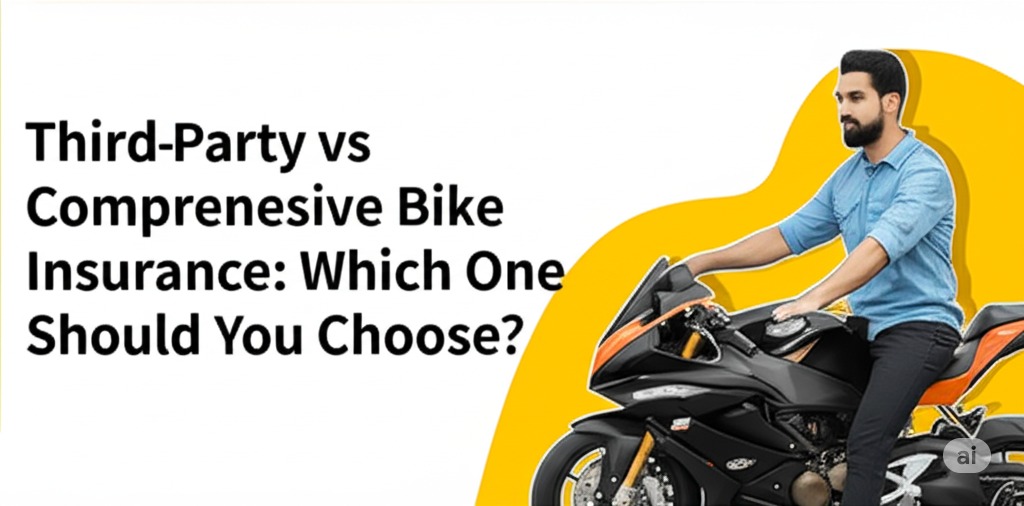Third-Party vs Comprehensive Bike Insurance: Which One Should You Choose?
Introduction
Bike insurance is more than just a legal requirement—it’s a smart way to protect yourself financially in case of accidents, theft, or third-party damage. When buying or renewing a two-wheeler insurance policy, one key decision stands out: Should you go for Third-Party Insurance or Comprehensive Insurance?
In 2025, with rising bike repair costs, increasing traffic, and stricter legal norms, making the right choice can save you from financial burdens. This article will break down both types of bike insurance in simple terms and help you decide which one suits your needs the best.
🔍 What Is Third-Party Bike Insurance?
Third-party insurance is the most basic form of bike insurance. It’s mandatory under the Motor Vehicles Act in India and many other countries.
✅ It Covers:
- Injuries to another person
- Death of a third party in an accident
- Damage to third-party property (e.g., another vehicle, building, etc.)
❌ It Doesn’t Cover:
- Damage to your own bike
- Theft or natural disasters
- Injuries to you (the policyholder)
This policy is designed to protect others from damages caused by your bike, not to protect your bike itself.
🔍 What Is Comprehensive Bike Insurance?
As the name suggests, comprehensive bike insurance offers broader protection. It includes everything that third-party insurance offers, plus own-damage coverage.
✅ It Covers:
- All third-party liabilities
- Damage to your own bike due to:
- Accidents
- Fire
- Theft
- Natural calamities (floods, earthquakes)
- Vandalism
- Personal accident cover (in many plans)
- Option to add add-on covers
❌ It Doesn’t Cover:
- Regular wear and tear
- Mechanical breakdowns
- Damage due to drunk driving or no license
🧮 Key Differences: Third-Party vs Comprehensive Bike Insurance
| Feature | Third-Party Insurance | Comprehensive Insurance |
|---|---|---|
| Legal Requirement | Mandatory | Optional but recommended |
| Premium Cost | Low | Higher |
| Own-Damage Cover | No | Yes |
| Theft Cover | No | Yes |
| Natural Disasters | No | Yes |
| Third-Party Damage | Yes | Yes |
| Add-ons Allowed | No | Yes |
| Customization | Limited | High |
| Claim Process | Simple | Detailed |
💰 Cost Comparison in 2025
In 2025, the premium for third-party insurance is fixed by the regulator in many countries (e.g., IRDAI in India), depending on the engine capacity.
- Example (India):
- Up to 75cc: ₹538
- 76cc to 150cc: ₹714
- 151cc to 350cc: ₹1,366
- Above 350cc: ₹2,804
On the other hand, comprehensive insurance depends on:
- Bike’s market value (Insured Declared Value or IDV)
- Age of the vehicle
- Location
- Add-ons selected
Pro Tip: If your bike is under 5 years old or expensive (sports bikes, EVs), comprehensive insurance is more cost-effective in the long run.
⚠️ Why Choosing the Right Plan Matters
Many first-time buyers think:
“I just want to meet legal requirements. Why spend extra?”
But here’s the reality:
- If your own bike is damaged, third-party insurance will pay you nothing.
- If your bike is stolen, you lose the entire investment unless you have comprehensive cover.
- Natural calamities are increasing globally—comprehensive insurance covers these.
- Accidents involving high repair costs are more common than you think.
🧠 Factors to Consider When Choosing
1. Bike Value
- Low-value, old bikes (5+ years) → Third-party might be enough.
- New or high-end bikes → Always go for comprehensive.
2. Usage Frequency
- Rarely used bike for short commutes → Third-party is okay.
- Daily use or long-distance rides → Comprehensive for better protection.
3. Location
- Urban areas with high traffic → Higher chances of theft and accidents.
- Flood-prone or high-crime zones → Go comprehensive.
4. Budget
- If you’re on a tight budget, third-party is legally enough.
- But if you can spend a bit more, comprehensive offers better peace of mind.
5. Risk Appetite
- Are you okay bearing loss if something happens to your bike?
- If not, comprehensive insurance is the safer choice.
🧩 Add-Ons Available with Comprehensive Insurance
Only comprehensive policies let you customize coverage with add-ons like:
| Add-On | Benefit |
|---|---|
| Zero Depreciation | Full claim without depreciation cuts |
| Roadside Assistance | Help during breakdowns |
| Engine Protection | Covers engine damage from floods |
| NCB Protection | Keeps No Claim Bonus even after 1 claim |
| Personal Accident Cover | Covers medical expenses for rider/pillion |
| Consumables Cover | Covers nuts, bolts, oils, etc. |
These may increase the premium, but offer high value during claims.
📜 Legal Penalties for Not Having Bike Insurance
If you ride without valid insurance, you may face:
- Fines (₹2,000–₹4,000 or more)
- License suspension
- Vehicle seizure
- Jail term (in extreme cases)
So even third-party insurance is a legal must, no matter what type of bike you ride.
📉 When Third-Party Insurance Makes Sense
✅ Ideal Scenarios:
- Bike is older than 5–7 years
- You don’t ride frequently
- Budget is extremely limited
- You’re selling the bike soon
- You’re okay paying for your own repairs
It’s a basic, no-frills policy that covers your legal obligations and helps others if you’re at fault.
🛡️ When Comprehensive Insurance Is Worth It
✅ Ideal Scenarios:
- Brand new or high-end bike (sports, electric, premium)
- Daily commuter
- Ride in risky areas (heavy traffic, poor roads, theft zones)
- You want peace of mind
- Bike is under finance (lenders usually require full coverage)
In all these cases, own-damage coverage is crucial for financial protection.
🧾 Claim Scenarios – Who Pays?
| Scenario | Third-Party Insurance | Comprehensive Insurance |
|---|---|---|
| You hit someone’s car | ✔️ Covers their damage | ✔️ Covers their damage + your bike |
| Your bike is stolen | ❌ Not covered | ✔️ Covered |
| Bike is damaged in a flood | ❌ Not covered | ✔️ Covered |
| Minor scratches or dents | ❌ Not covered | ✔️ Covered |
| You get injured in crash | ❌ Only if PA cover exists | ✔️ Usually covered |
| Another vehicle damages your bike | ✔️ They should pay | ✔️ You can claim faster and then recover from third-party |
🏁 Final Verdict: Which One Should You Choose?
Here’s a quick recommendation:
| Bike Type | Recommendation |
|---|---|
| Budget/Old Bike | Third-Party |
| New Bike (<5 years) | Comprehensive |
| Premium/Sports Bike | Comprehensive |
| Daily Use | Comprehensive |
| Occasional Use | Third-Party (if older) |
| Loan-financed Bike | Comprehensive (mandatory by lenders) |
Bottom Line:
If you want only legal compliance, go for third-party.
If you want complete peace of mind, comprehensive is the way to go.
🔑 Summary Table: Third-Party vs Comprehensive
| Feature | Third-Party | Comprehensive |
|---|---|---|
| Legal Compliance | ✔️ | ✔️ |
| Own-Damage Cover | ❌ | ✔️ |
| Theft Protection | ❌ | ✔️ |
| Natural Disasters | ❌ | ✔️ |
| Premium Cost | Low | Moderate to High |
| Customization | No | Yes |
| Claim Amount | Limited | Full value (with IDV) |
📝 Final Thoughts
Choosing between third-party and comprehensive bike insurance depends on your needs, usage pattern, and budget. While third-party plans are cheaper, they only fulfill legal obligations. Comprehensive insurance gives you a complete safety net for a slightly higher cost.
In 2025, with increasing accidents, vehicle theft, and erratic weather, it’s wise to think long-term and protect your asset properly.


